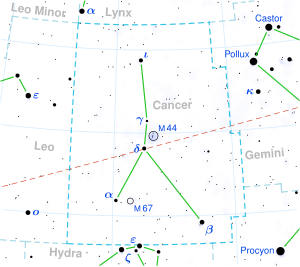astro.wikisort.org - Star
LHS 2090 is a red dwarf star of spectral type M6.5V, located in constellation Cancer at 20.8 light-years from Earth.[10]
| Observation data Epoch J2000.0 Equinox J2000.0 | |
|---|---|
| Constellation | Cancer |
| Right ascension | 09h 00m 23.594s[1] |
| Declination | +21° 50′ 05.43″[1] |
| Apparent magnitude (V) | 16.11[2] |
| Characteristics | |
| Evolutionary stage | Main-sequence star[2] |
| Spectral type | M6.5 V[3] |
| Apparent magnitude (J) | 9.44[2] |
| Astrometry | |
| Radial velocity (Rv) | 23.3[2] km/s |
| Proper motion (μ) | RA: -514.942 mas/yr[4] Dec.: -592.253 mas/yr[4] |
| Parallax (π) | 157.2686 ± 0.0535 mas[4] |
| Distance | 20.739 ± 0.007 ly (6.359 ± 0.002 pc) |
| Details | |
| Mass | 0.09[5] M☉ |
| Radius | 0.12[6] R☉ |
| Luminosity | 0.00082[7] L☉ |
| Temperature | 2680±24[7] K |
| Metallicity [Fe/H] | -0.06±0.17[8] dex |
| Rotation | 0.439 d[6] |
| Rotational velocity (v sin i) | 15.0±1.0[6] km/s |
| Other designations | |
| Database references | |
| SIMBAD | data |
 LHS 2090 Location of LHS 2090 in the constellation Cancer | |
The star was identified to be a red dwarf at short distance (6 parsecs from Sun) in 2001.[11] As typical for very cool red dwarfs, its spectrum is dominated by molecular water absorption. Stellar metallicity is similar to that of Sun`s.[8]
Radial velocity measurements did not yield any detection of stellar companion or giant planet on orbit around LHS 2090, as in 2018.[2]
References
- Cutri, R. M.; et al. (2003). "2MASS All-Sky Catalog of Point Sources". VizieR On-line Data Catalog. Bibcode:2003yCat.2246....0C.
- The Solar Neighborhood XLIV: RECONS Discoveries within 10 Parsecs, 2018, arXiv:1804.07377
- Alonso-Floriano, F. J.; Morales, J. C.; Caballero, J. A.; Montes, D.; Klutsch, A.; Mundt, R.; Cortés-Contreras, M.; Ribas, I.; Reiners, Ansgar; Amado, P. J.; Quirrenbach, A.; Jeffers, S. V. (2015). "CARMENES input catalogue of M dwarfs" (PDF). Astronomy & Astrophysics. 577: A128. arXiv:1502.07580. doi:10.1051/0004-6361/201525803. S2CID 53135130.
- Brown, A. G. A.; et al. (Gaia collaboration) (2021). "Gaia Early Data Release 3: Summary of the contents and survey properties". Astronomy & Astrophysics. 649: A1. arXiv:2012.01533. Bibcode:2021A&A...649A...1G. doi:10.1051/0004-6361/202039657. S2CID 227254300. (Erratum: doi:10.1051/0004-6361/202039657e). Gaia EDR3 record for this source at VizieR.
- A 3D search for companions to 12 nearby M dwarfs, 2015, arXiv:1501.05012
- Fouqué, Pascal; et al. (April 2018), "SPIRou Input Catalogue: global properties of 440 M dwarfs observed with ESPaDOnS at CFHT", Monthly Notices of the Royal Astronomical Society, 475 (2): 1960–1986, arXiv:1712.04490, Bibcode:2018MNRAS.475.1960F, doi:10.1093/mnras/stx3246.
- The solar neighborhood. XXXII. The hydrogen burning limit, 2013, arXiv:1312.1736
- Metallicity and temperature indicators in M dwarf K-band spectra: testing new and updated calibrations with observations of 133 solar neighborhood M dwarfs, 2011, arXiv:1112.4567
- "LHS 2090". SIMBAD. Centre de données astronomiques de Strasbourg. Retrieved 29 January 2018.
- Henry, T. J.; Jao, Wei-Chun; Subasavage, John P.; Beaulieu, Thomas D.; Ianna, Philip A.; Costa, Edgardo; Méndez, René A. (2006). "The Solar Neighborhood. XVII. Parallax Results from the CTIOPI 0.9 m Program: 20 New Members of the RECONS 10 Parsec Sample" (PDF). The Astronomical Journal. 132 (6): 2360–2371. arXiv:astro-ph/0608230. Bibcode:2006AJ....132.2360H. doi:10.1086/508233.
{{cite journal}}: CS1 maint: multiple names: authors list (link) - Search for nearby stars among proper motion stars selected by optical-to-infrared photometry I. Discovery of LHS 2090 at spectroscopic distance of d ∼ 6 pc, 2001, arXiv:astro-ph/0106222
На других языках
- [en] LHS 2090
[ru] LHS 2090
LHS 2090 — звезда, которая находится в созвездии Рак на расстоянии приблизительно 20,7 светового года от нас[10]. Это одна из ближайших к нам звёзд.Текст в блоке "Читать" взят с сайта "Википедия" и доступен по лицензии Creative Commons Attribution-ShareAlike; в отдельных случаях могут действовать дополнительные условия.
Другой контент может иметь иную лицензию. Перед использованием материалов сайта WikiSort.org внимательно изучите правила лицензирования конкретных элементов наполнения сайта.
Другой контент может иметь иную лицензию. Перед использованием материалов сайта WikiSort.org внимательно изучите правила лицензирования конкретных элементов наполнения сайта.
2019-2025
WikiSort.org - проект по пересортировке и дополнению контента Википедии
WikiSort.org - проект по пересортировке и дополнению контента Википедии